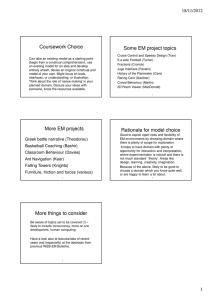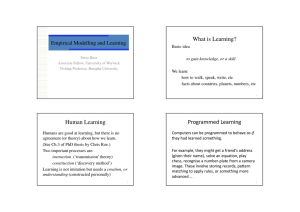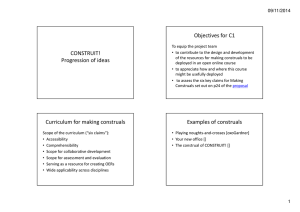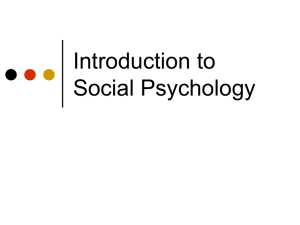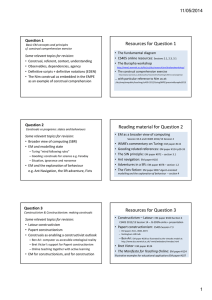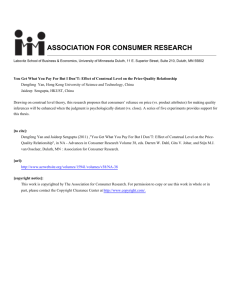Educational Technology: Complex Data Structures Through Construals Abstract 1008010
advertisement
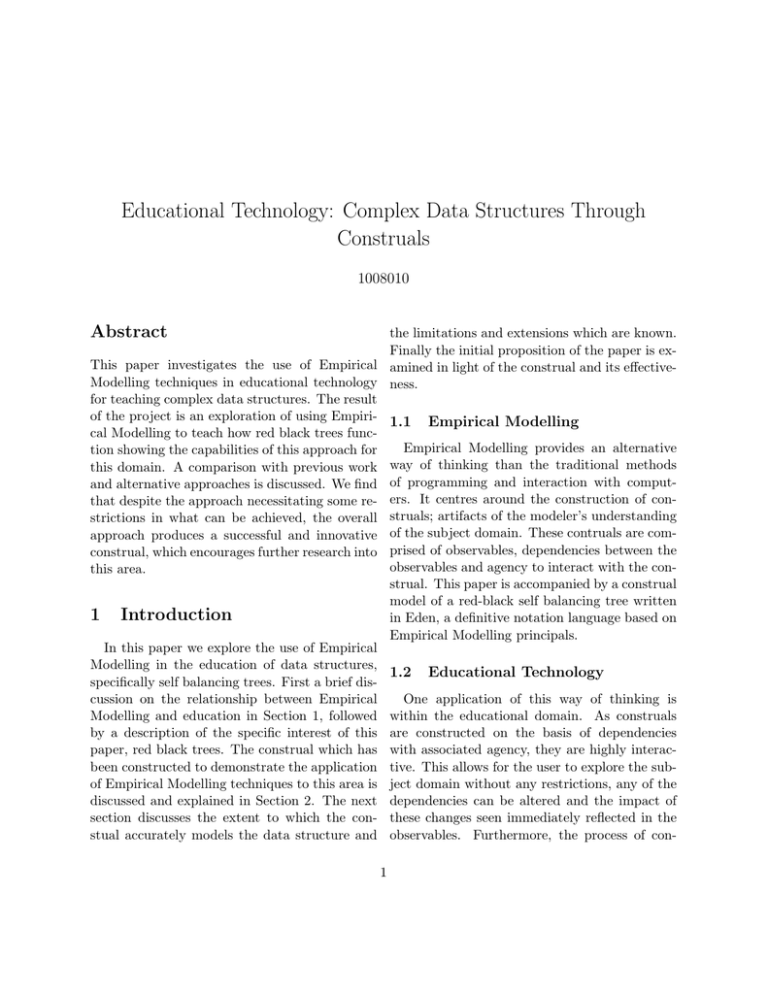
Educational Technology: Complex Data Structures Through Construals 1008010 Abstract the limitations and extensions which are known. Finally the initial proposition of the paper is exThis paper investigates the use of Empirical amined in light of the construal and its effectiveModelling techniques in educational technology ness. for teaching complex data structures. The result of the project is an exploration of using Empiri- 1.1 Empirical Modelling cal Modelling to teach how red black trees funcEmpirical Modelling provides an alternative tion showing the capabilities of this approach for this domain. A comparison with previous work way of thinking than the traditional methods and alternative approaches is discussed. We find of programming and interaction with computthat despite the approach necessitating some re- ers. It centres around the construction of constrictions in what can be achieved, the overall struals; artifacts of the modeler’s understanding approach produces a successful and innovative of the subject domain. These contruals are comconstrual, which encourages further research into prised of observables, dependencies between the observables and agency to interact with the conthis area. strual. This paper is accompanied by a construal model of a red-black self balancing tree written 1 Introduction in Eden, a definitive notation language based on Empirical Modelling principals. In this paper we explore the use of Empirical Modelling in the education of data structures, 1.2 Educational Technology specifically self balancing trees. First a brief disOne application of this way of thinking is cussion on the relationship between Empirical Modelling and education in Section 1, followed within the educational domain. As construals by a description of the specific interest of this are constructed on the basis of dependencies paper, red black trees. The construal which has with associated agency, they are highly interacbeen constructed to demonstrate the application tive. This allows for the user to explore the subof Empirical Modelling techniques to this area is ject domain without any restrictions, any of the discussed and explained in Section 2. The next dependencies can be altered and the impact of section discusses the extent to which the con- these changes seen immediately reflected in the stual accurately models the data structure and observables. Furthermore, the process of con1 these explanations”[5]. Therefore, removing this barrier to the comprehension of these concepts could be found through the use of construals for practice based learning to accompany the standard teaching methods employed. This practice based learning approach is favored in educational There has already been various discussions re- research.[6] garding the application of Empirical Modelling techniques to the educational sector as well as 2 Red Black Tree Construal the development of construals to demonstrate its application.[1][2][3] This paper adds to this 2.1 Red Black Trees growing work as well as builds upon previous The need to store and access data efficiently ideas and construals and aims to show the posis the reason behind complex data structures.[4] sibility of teaching complex ideas in computer This leads to the use of progressively more comscience through the use of construals. plex structures with more specific contexts but which provide improvements in performance. Bi1.3 Data Structures nary search trees are one of these well studied An important part of an education in com- stat structures and is commonly taught when inputer science is a grounding in the theory of troducing the key concepts of data storage and not only simple data structures but more com- retrieval.[4] However, a major drawback of simplex and useful ones.[4] However, grasping these ple binary search trees is the tree becoming unconcepts is regarded as a difficult task, espe- balanced, one side of the tree becoming signifcially when confronted with more convoluted icantly longer than the other reducing the effidata structures which have complex logic behind ciency of searches. them.[5] Personal experience has been consistent with this, especially when studying the advanced Red black trees are an extension of binary data structures and algorithms modules in pre- search trees and part of the self balancing binary vious years. search tree family. As well as the usual binary search tree insertion rules, extra conditions and One would postulate from experience that a properties for each node are used to re-organise significant reason for this is the reliance on rigid the tree each time a new node is added.[7] These textbook proofs as the basis for understand- constraints assure that the tree is evenly baling. This level of detachment from the use of anced to keep the lowest possible access times, the theory could possibly be a significant rea- O log n in practice.[7] son for these perceived difficulties. The reEach node in the tree is assigned a colour, red search done at Virginia Tech support this theory, ”lecture instructors typically draw on a or black, hence the name of the data structure. board, trying to illustrate dynamic processes... There are three main conditions which need to many students have a hard time understanding be imposed to ensure the tree is balanced: structing a construal also provides the modeler with the opportunity to explore the domain, in which it resides in a alternative fashion, allowing for their personal knowledge of the subject domain to be explored and enhanced also. 2 • Every node is red or black • The children of a red node are both black • Every path from a node to a leaf has the same number of black nodes[7] The third constraint is the main reason that the tree remains balanced and this is achieved by various re-colourings and rotations of the nodes each time a new node is inserted. There are 5 main cases which are identified as requiring various actions to maintain the third property.[7] These are however symmetrical cases and so result in more cases handled when implemented. 2.2 Figure 1: The heapsort construal[8] Heapsort Construal in the heapsort construal and the order in which The inspiration for choosing this domain is a items are added to the tree in the red black tree. previously constructed construal based around the heap concept. The heapsort construal displays an initially unsorted heap with the heap conditions expressed through the colour of the edges between nodes. The construal also is able to visually automate the sorting process through the user clicking to update the observables as the heap is sorted. There is much similarity between the heapsort and the red black tree, they both aim to sort data into readily accessible structures and furthermore on a visual level are strikingly simFigure 2: Red black tree construal in Eden ilar. This is one aspect which the construal exercise was hoped to bring out, the relationship between two differing data structures being identified through the construal in unexpected ways. 2.3 Observables Similarly the relationship between the array and the tree, in both construals, can be seen through All of the nodes and edges in the tree and the dependency between the order of the values the values in the array, are observables in the 3 It is also possible to interact with the construal through the Eden interpreter, here definitions can be altered, values in the tree changed and observables added. This allows for extra scope for interaction than would traditionally be possible and no restriction on what can be done to the model. By changing certain observables the effects upon the binary tree and red black tree rules can be investigated allowing for a more inquisitive exploration of their logic. red black tree construal. Their values are updated as the user interacts with the model and the changes to their states can be seen immediately. This feedback allows for the exploration of the relationship between the observables and how the theory of the data structure effects the components which it is comprised from. 2.4 Dependency The colours of the edges between each node are dependencies which are based on the binary tree insertion conditions similar to the heap con- 3 Evaluation ditions in the heapsort construal. Red indicates 3.1 Advantages that one or more of the conditions is not met in the current position and so the node is moved The construal successfully displays the proto different positions until a correct position is cess of creating and maintaining a red black tree found. within an Empirical Modelling framework. The resulting trees keep to the required conditions This dependency allows for the interaction and also display the process of initially adding with the rules which govern binary tree inser- nodes to a binary search tree. Hence, without tion in a interesting way. The colour of the lines having the initial intention to achieve this, the make the type of rule violation clear, by either construal is educational for understanding how being a single red edge long, indicating that the binary search trees function, an unexpected yet node is on the wrong side of the parent, or mul- welcome addition to the construal. tiple red edges indicating that the node should be on the complete other side of the tree. 2.5 As previously mentioned the ability to manipulate the observables and dependencies through the Eden interpreter is a significant advantage to using an Empirical Modelling framework and provides the initially intended flexibility for the user to explore the model in their personal way, building up their own understanding. Finally, the automation of both the binary tree insertion and the application of the red black tree reorganisation is an achievement. Building on the ideas used in the automation of the heapsort construal this successfully shows the user the whole process of maintaining the tree whilst also providing control through agency in the buttons and Agency To interact with the construal there are buttons on the left side of the window which allow for the addition and removal of nodes. This is the main way in which the model is manipulated, once added the process of finding the correct place within in tree is shown by the user clicking on the model. The final button applies the red black tree rules to the newly added node, showing how the nodes are re-coloured and rotated. 4 3.3 clicking to advance the process. A desirable extension to the construal would be to enable larger sets of data to be added to the tree through dynamic generation of observables when the current tree is not large enough to display the required nodes. Although the dependencies and logic are already in place for this. There is also scope to add the ability to view which red black tree conditions are being rectified with each rotation or re-colouring within the construal. This may aid in the comprehension of the individual rules which are enforced. Whilst developing the construal, the understanding of the domain, and the relationship between the rules of red black trees and the reasoning behind them, became much more clear. Furthermore, the relationship between a basic binary search tree and the more complex red black tree also became better understood. From this experience of developing the construal, one can extrapolate that a similar benefit would result in interacting with it to learn about red black trees. Hence, to some extent the use of Empirical Modelling principals to education within complex data structures has been successful. 3.2 Extensions 4 Conclusion The success of the model in conceptually delivering a complex construal in an accessible way leads to desiring more development of such work. Empirical studies with students learning these concepts for the first time would be a welcome next step to determine how much of an impact this sort of resource can make. Perhaps extending the construal to encapsulate more data structures to show the interdependency between them and the common similarities such as those seen within the heapsort and red black tree construals would be useful in unifying this with previous research. Limitations There are various compromises which were accepted when using the Empirical Modelling methodology in creating this construal with the currently available tools. For example, as the observables are defined in the model, dynamically changing the size of the tree is problematic. In cases where adding nodes to the tree in a binary search fashion required more than a depth of 4 in the tree, the construal would not be able to accommodate this. Therefore, the number of items which could be added to the tree was limited from the original 7 in the heapsort construal down to 5 to avoid this situation. The project set out to explore the use of an Empirical Modelling methodology to the teaching of complex data structures and has achieved this aim. Overall the success of the construal is currently ambiguous due to the lack of empirical studies, however, the personal experience of the writer and understanding gained from the modelling process, seems to suggest that this is a profitable approach for learning and hence more research into the area is recommended. Furthermore, the rotation of nodes to maintain the red black properties occurs immediately. A more desirable approach would be to move them gradually to emphasise the reasons behind the way in which nodes are re-arranged. This proved to difficult to include in the construal due to way in which the observables are defined. 5 References [1] R. Boyatt, A. Harfield & W. M. Beynon, Learning about and through Empirical Modelling, Department of Computer Science, University Of Warwick (2005) [2] W. M. Beynon, Empirical Modelling for Educational Technology, Department of Computer Science, University Of Warwick (1997) [3] EM for Learning - A Modeler’s Experience, WEB-EM 07, Department of Computer Science, University of Warwick (2011) [4] K. Mehlhorn, P. Sanders, Preface, Algorithms and Data Structures - The Basic Tool Box, Springer (2008) [5] S. Hall, C. A. Shaffer, Evaluating Online Tutorials for Data Structures and Algorithms Courses, Virginia Polytechnic Institute and State University (2013) [6] R. Alexandre, A framework for practicebased learning applied to computer programming, Department of Computer Science, Faculty of Sciences, of University of Porto (2012) [7] A. Mantler, Constructing Red-Black Tree Shapes, Department of Computer Science, University Of North Carolina (2001) [8] W. M. Beynon, J. Rungrattanaubol & J. Sinclair, Formal specification from an observation-oriented perspective, Department of Computer Science, University Of Warwick (2008) 6
